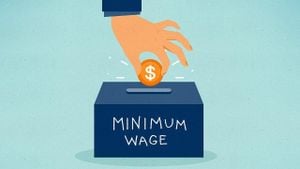President Donald Trump has confirmed the implementation of 25% tariffs on imports from Canada and Mexico, effective this Saturday, February 1, 2025. This decisive action is expected to raise prices for consumers on everyday items and spark retaliatory measures from both countries, which are among the United States’ primary trading partners.
The announcement, made during a recent press conference, emphasized Trump's belief in tariffs as tools to reduce trade deficits and combat illegal immigration and drug trafficking. "A lot of fentanyl, which has devastated communities across America, flows through Canada, and China is the main manufacturer of it," Trump stated, linking tariffs to efforts to safeguard national security.
Canada and Mexico accounted for significant portions of U.S. imports in 2023, with nearly $25 billion traded between Wisconsin and these nations alone. Following the tariffs, economists predict steep price increases for various consumer goods including clothing, groceries, and automotive products. This could leave American families grappling with tighter budgets amid rising inflation.
Senators Tim Kaine (D-VA) and Chris Coons (D-DE) have responded to Trump's aggressive tariff plans by introducing the Stopping Tariffs on Allies and Bolstering Legislative Exercise of (STABLE) Trade Policy Act. This proposed legislation aims to require Congressional approval for any new tariffs imposed on U.S. allies, addressing concerns over the unilateral nature of Trump's trade policy. Kaine articulated the sentiment of many Americans when he said, "Virginians want costs to go down, not up. But President Trump’s plans to impose broad-based tariffs would raise the price of everyday goods and hurt our economy."
Indeed, tariffs are applied as taxes on imports, which typically lead to higher prices for consumers. For example, goods imported from Canada such as wood, aluminum, and agricultural items like corn and fruit may see marked price hikes. From Mexico, items like avocados, processed fruits, and beer are also likely to become more expensive. The 10% tariff on imports from China adds another layer of complexity, affecting products widely consumed across the U.S.
The immediate aftermath of these tariffs presents challenges for businesses. Many industry leaders have voiced concerns about the potential for retaliation, which could exacerbate tensions between the U.S. and its trade partners. Businesses, particularly within the agricultural sector, could experience substantial losses if tariffs lead to diminished market access. Charles Nicholson, dairy economist at Cornell University, noted, "If you pick a trade fight with our major export destinations — Mexico, Canada, and China — and they decide to retaliate, it has substantive negative implications for dairy farms and processors."
Critically, should Canada and Mexico impose tariffs on U.S. exports, American companies may find themselves caught in what could escalate to a full-fledged trade war. Current predictions suggest Mexico could retaliate by imposing tariffs primarily on U.S. agricultural products, which would directly affect farmers and producers reliant on such markets.
Historic data indicates past tariffs initiated by the Trump administration did not lead to drastic price inflation on consumer goods; nonetheless, the anticipated broad scope of the current tariffs raises alarm bells among economists. Trump himself has acknowledged potential short-term disruptions but expressed confidence Americans would accept these sacrifices for long-term benefits. "You see the power of the tariff. No one can compete with us because we have by far the biggest piggy bank," he stated, reinforcing his belief in the protective nature of tariffs.
Beyond immediate price hikes, the long-term repercussions could alter US-Mexico and US-Canada relations significantly. Canada, already touching on trade disputes over dairy tariffs, is expected to respond strongly to the 25% tariffs, potentially implementing similar measures. Analysts predict Canada may retaliate with across-the-board tariffs on U.S. imports, according to Satyam Panday, chief economist at S&P Global.
Some supporters of Trump's tariff initiative argue it protects U.S. manufacturers against unfair competition from foreign markets. John Murphy, senior vice president of the U.S. Chamber of Commerce, offered caution against this rationale, warning, "If imposed, tariffs themselves would not solve our border problems and instead would send prices soaring, costing the typical American family more than $1,000, with significant harm to U.S. manufacturers, farmers, and ranchers."
Compounding these concerns, consumers are already facing financial strain from inflationary pressures. The anticipated price increases resulting from tariffs may cut deeply, compelling families to reevaluate their spending habits and potentially hindering economic recovery efforts.
Overall, President Trump’s tariffs represent not just economic policy but also a strategic move to reshape trade relations and address pressing national issues. The effectiveness of this approach will hinge on various factors, including how trading partners respond and whether Congress can assert greater oversight over future trade decisions. Only time will tell the ultimate impact of this bold trade maneuvering on both the U.S. economy and its relationships with pivotal allies.



